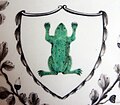Portal:Frogs
The Frogs PortalA frog is any member of a diverse and largely semiaquatic group of short-bodied, tailless amphibian vertebrates composing the order Anura (coming from the Ancient Greek ἀνούρα, literally 'without tail'). Frog species with rough skin texture due to wart-like parotoid glands tend to be called toads, but the distinction between frogs and toads is informal and purely cosmetic, not from taxonomy or evolutionary history. Frogs are widely distributed, ranging from the tropics to subarctic regions, but the greatest concentration of species diversity is in tropical rainforest and associated wetlands. They account for around 88% of extant amphibian species, and are one of the five most diverse vertebrate orders. The oldest fossil "proto-frog" Triadobatrachus is known from the Early Triassic of Madagascar (250 million years ago), but molecular clock dating suggests their divergence from other amphibians may extend further back to the Permian, 265 million years ago. Adult frogs have a stout body, protruding eyes, anteriorly-attached tongue, limbs folded underneath, and no tail (the "tail" of tailed frogs is an extension of the male cloaca). Frogs have glandular skin, with secretions ranging from distasteful to toxic. Their skin varies in colour from well-camouflaged dappled brown, grey and green, to vivid patterns of bright red or yellow and black to show toxicity and ward off predators. Frog skin also has a rich microbiome which is important to their health. Adult frogs live in both fresh water and on dry land; some species are adapted for living underground or in trees. As their skin is semi-permeable, making them susceptible to dehydration, they either live in moist niches or have special adaptations to deal with drier habitats. Frogs produce a wide range of vocalisations, particularly in their breeding season, and exhibit many different kinds of complex behaviors to attract mates, to fend off predators and to generally survive. (Full article...) Selected article -Rheobatrachus, whose members are known as the gastric-brooding frogs or platypus frogs, is a genus of extinct ground-dwelling frogs native to Queensland in eastern Australia. The genus consisted of only two species, the southern and northern gastric-brooding frogs, both of which became extinct in the mid-1980s. The genus is unique because it contains the only two known frog species that incubated the prejuvenile stages of their offspring in the stomach of the mother. The combined ranges of the gastric-brooding frogs comprised less than 2,000 square kilometres (770 sq mi). Both species were associated with creek systems in rainforests at elevations of between 350 and 1,400 metres (1,150 and 4,590 ft). The causes of the gastric-brooding frogs' extinction are not clearly understood, but habitat loss and degradation, pollution, and some diseases may have contributed. (Full article...)
Selected imageNeed help?Do you have a question about Frogs that you can't find the answer to? Consider asking it at the Wikipedia reference desk. General imagesThe following are images from various frog-related articles on Wikipedia.
Did you know?
TopicsQuality ContentFeatured frog and toad-related articles - Australian green tree frog - Cane toad - Common toad - Frog - Green and golden bell frog
Good frog and toad-related articles - American bullfrog - Boiling frog - Ecnomiohyla rabborum - Poison dart frog Related portalsThings you can do
Associated WikimediaThe following Wikimedia Foundation sister projects provide more on this subject:
Discover Wikipedia using portals |

































































